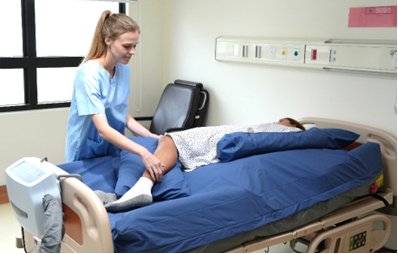Repositioning patients to prevent pressure injuries

Repositioning and mobilizing individuals is an important component in the prevention of pressure injuries.1
Introduction to Pressure Injuries
Pressure injuries are a frequently occurring health problem throughout the world. They are a painful, costly, and often preventable complication for which many individuals are at risk. Around the world, pressure injury prevalence in healthcare settings ranges from 0% to 72.5%, with large variations observed between different geographic and clinical settings. Pressure injuries represent a major burden of sickness and reduced quality of life for patient consumers and their care givers.1
Understanding Pressure Injuries: Causes and Stages
A pressure injury refers to localized damage to the skin and underlying tissues caused by prolonged pressure or a combination of pressure and shear. They are most common over bony prominences but can also occur due to medical devices.1
Risk factors include 2,3
- Patient Factors: Mobility level, sensory perception, nutritional status, and overall health.
- External Factors: Pressure, shearing, and increased temperature.
- Additional Factors: Friction, moisture, hygiene, and time spent in one position.
According to the 2019 EPUAP/NPIAP/PPPIA Clinical Practice Guideline, the stages of pressure injuries are as follows:1

Stage 1: Intact skin with non-blanchable redness.
Stage 2: Partial thickness loss of skin (shallow ulcer or blister).
Stage 3: Full thickness loss of skin, with visible fat; may have undermining.
Stage 4: Full thickness loss with exposed bone, tendon, or muscle; often includes undermining.
Unstageable: Full thickness loss with slough/eschar obscuring depth.
Suspected Deep Tissue Injury: Purple/maroon area of intact skin or blood-filled blister indicating damage to underlying tissue.
- Check bony prominence: Ensure all bony prominences are adequately offloaded by checking that pressure areas receive intended relief. Focus on heels, which are vulnerable even with frequent repositioning.
- Optimal Positioning: According to the 2019 EPUAP/NPIAP/PPPIA Clinical Practice Guideline, use the 30° side-lying position instead of the 90° side-lying position. Encourage individuals who can reposition themselves to sleep in a 20° to 30° side-lying position or flat in bed if not contraindicated.
- Repositioning Frequency: According to the 2019 EPUAP/NPIAP/PPPIA Clinical Practice Guideline, determine repositioning frequency with consideration to the individual’s level of activity and ability to independently reposition. The studies demonstrated that different repositioning frequencies (e.g. two, three or four hourly) are all at least somewhat effective.
Daily Care and Prevention Methods for Pressure Injuries1
- Skin Monitoring: Regularly assess pressure points and existing injuries to track healing.
- Skin Care: Maintain skin hygiene by keeping it clean, hydrated, and protected from moisture with barrier products.
- Repositioning Plan: Ensure individualized repositioning schedules to prevent prolonged pressure on bony areas.
- Pressure Relief Surfaces: Select appropriate support surfaces based on the patient's immobility, weight, and injury risk.
- Nutrition: According to the 2019 EPUAP/NPIAP/PPPIA Clinical Practice Guideline, provide adequate nutrition, including 30-35 kcal/kg/day and 1.25-1.5 g protein/kg/day to support tissue repair for adults with a pressure injury who are malnourished or at risk of malnutrition.
- Repositioning Prioritization and Workflow Optimization: Prioritize pressure injury prevention within the care routine. This might involve rearranging tasks or workflow to ensure that repositioning and pressure relief are consistently addressed.
- Decrease Labor-Intensive Workload: Turn-assisting support surfaces reduce caregivers' workload and labor intensity by up to 20% during a partnered log rolling maneuver.4,5
- Access multiple therapy modes: Care providers can switch between different therapy modes to deliver high-quality and flexible patient care according to the patient's recovery status, without moving the patient to and from different mattresses.
- Access multiple therapy modes: Offers CLP, alternating, and turning therapy modes, tailored to the patient, delivering both comfort and pressure relief functions.
- Consistent turning speed and angle: Slow and consistent turning ensures a smooth and comfortable repositioning experience for the patient.
- Optimal patient safety during turning: Firm air cell side bolsters combined with the bed rails prevent the patient from slipping off the mattress and feeling trapped, uncomfortable, or hurt by the railings during turning.
- European Pressure Ulcer Advisory Panel, National Pressure Injury Advisory Panel and Pan Pacific Pressure Injury Alliance. Prevention and Treatment of Pressure Ulcers/Injuries: Clinical Practice Guideline. The International Guideline. Emily Haesler (Ed.). EPUAP/NPIAP/PPPIA: 2019
- Lindgren, M., Unosson, M., Fredrikson, M., & Ek, A. C. (2004). Immobility--a major risk factor for development of pressure ulcers among adult hospitalized patients: a prospective study. Scandinavian journal of caring sciences, 18(1), 57–64. https://doi.org/10.1046/j.0283-9318.2003.00250.x
- National Pressure Injury Advisory Panel. (2019, March 13). Pressure Injury Prevention--Repositioning Frequency. Npiap.com. https://npiap.com/store/viewproduct.aspx?id=14123202
- Skotte, J., & Fallentin, N. (2008). Low back injury risk during repositioning of patients in bed the influence of handling technique, patient weight and disability. Ergonomics, 51(7), 1042–1052. https://doi.org10.108000140130801915253
- Budarick, A. R., Lad, U., & Fischer, S. L. (2020). Can the Use of Turn-Assist Surfaces Reduce the Physical Burden on Caregivers When Performing Patient Turning?. Human factors, 62(1), 77–92. https://doi.org/10.1177/0018720819845746

